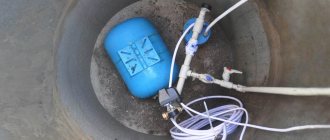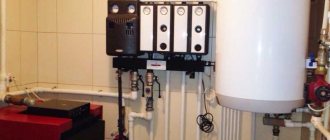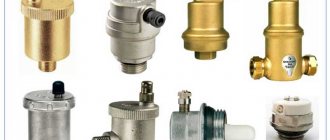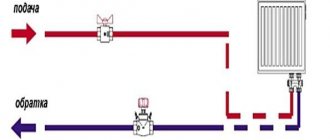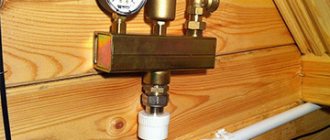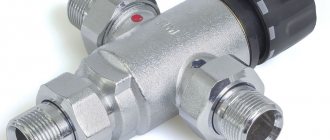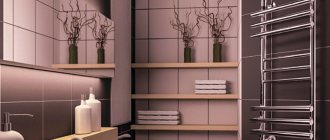A heated towel rail is a necessary attribute of any bathroom, ensuring the comfort of its use; without it it is impossible to imagine a modern apartment or country house. When carrying out construction or repair work yourself or moving the device to another location during reconstruction, it is important to know how to connect a heated towel rail to the heating system.
The task is complicated by the fact that there are different types of heated towel rails and ways to connect them; to choose the best option, it is useful to study the basic diagrams of their location. And studying the correct installation technology will allow you to avoid uneven heating or its absence, airing of the system and leaks, which are a fairly common occurrence among errors when installing the device.
Rice. 1 Heated towel rails for bathrooms - varieties
Connecting a water heated towel rail - features
A heated towel rail is an important attribute that creates increased convenience when using the bathroom, in which it performs the following functions:
- Drying towels that are wet after washing and washing clothes and shoes.
- Heating the bathroom for a comfortable stay in the room after taking a bath or shower.
- Combating dampness affecting finishing materials, electrical sockets and lamps, heating boilers and household appliances.
The heated towel rail is connected to the heating or hot water supply system by parallel or series connection to the pipeline through which hot water flows.
Any heated towel rail has an inlet and outlet pipe with a thread at the end for quick and convenient connection to pipes. In some schemes, the heated towel rail becomes part of the pipeline, placed in the gap in place of the cut section of the pipe. During installation, it is welded to pipes or installed on American-type threaded connections.
Rice. 2 Design and equipment of the ladder heated towel rail
Types of heated towel rails
Heated towel rails connected to the pipeline are divided into three main categories:
- Mermen. The main type in all apartment buildings and private buildings, they work on the principle of circulating water through a heated towel rail, and are a piece of curved pipe of various shapes or a ladder with threaded outlet pipes. In old houses, the element was often connected to heating pipes and it functioned only during the heating season; in modern residential high-rise buildings, the heated towel rail is connected to the hot water supply pipeline.
- Electrical. The device is a regular autonomous heating element not connected to water; it can be installed anywhere in the apartment: in the bathroom, in the kitchen, in the loggia. Although this device is a modern development, its use in the household is limited due to high energy consumption and additional financial costs for electricity.
- Combined. Such models combine water and electric heating of the heated towel rail, which is very convenient when connecting it to the heating system. In this case, during the heating season, the heated towel rail operates due to hot water passing through it, and when the heating is turned off, heating occurs due to electricity. This option is less popular due to its higher cost.
Rice. 3 Electric coil - modifications
Main materials of manufacture - comparison of characteristics
The main materials for the manufacture of heated towel rails are stainless steel and brass; in budget options, galvanized steel is used for installation in apartment buildings. When choosing, the buyer often gives preference to the widely advertised stainless steel, which has an aesthetic appearance. To determine which metal is better, their main characteristics should be compared in terms of efficiency as materials for heat exchange devices.
If we consider stainless steel, it is almost three times cheaper than brass or copper, can withstand temperatures of more than 450º C, and is slightly susceptible to corrosion in water. Although stainless steel is corrosion-resistant and is not afraid of the effects of solutions of most acids and alkalis, if the alloy is made poorly (violation of technology, structural defects, reduced content of the main alloying additives of chromium), corrosion processes can occur in the structure. The material has high strength and durability, is harmless throughout the entire period of operation, but non-ferrous metals are used much less frequently as parts of plumbing fittings.
Copper-based brass alloys have thermal conductivity 4 times higher than stainless steel, which is the main advantage when using the material as a heat exchanger. Brass has high corrosion resistance (its surface is covered with a protective film of oxides, which serves as a barrier against the penetration of oxygen into the pure metal). Non-ferrous metals, unlike steels, are not subject to electrochemical corrosion; when used, the maximum temperature of the flowing coolant should not exceed 260º C.
Rice. 4 Types of heated towel rails - U-shaped, M-shaped and ladder
Short description
Don’t forget about the appearance of the product – the aesthetics of the room depend on it.
The placement of the device is divided into several stages, knowledge of which will allow you to independently install a stainless steel water heated towel rail.
Installation solves several problems:
- the ability to dry towels and small items;
- maintaining an optimal microclimate;
- prevents the formation of condensation.
What designs are there?
The main diameter of the pipe for a heated towel rail is 32 mm; if the body has a complex structure in the form of a ladder with welded pipe sections, their diameter is about 20 mm. On the market you can find other dimensional parameters of the main pipeline with an outer diameter of 26, 28, 50 mm.
All structures can be divided into two categories: single-pipe U-shaped or M-shaped and multi-pipe, consisting of two pipe sections of large diameter and small cross-section pipes located between them in the form of a ladder.
Some models provide for connection using special seals that allow the device to be rotated around its axis; in other modifications, a set of heated towel rails is possible from several fragments connected in series to each other. To connect the heated towel rail to the water riser, use a bottom, side or diagonal connection - this is how the inlet and outlet pipes are located in manufactured models.
Rice. 5 Single-pipe arrangement of a heated towel rail in the system
GOST standards
The main document regulating the procedure for connecting the receiver to the hot water supply system is SNiP 2.04.01.85. Most of the standards were developed taking into account the old methods of manufacturing heated towel rails, but they are still in effect today. When installing devices, it is necessary to ensure:
- The distance from the axis of the pipe to the wall should be 35–55 mm (the norm is clearly outdated and does not take into account the size of modern devices).
- The direction of coolant circulation is from top to bottom.
- The diameter of the riser or supply pipeline must be less (at least equal) to the diameter of the heated towel rail pipe, so as not to create a narrowing of the clearance and a pressure drop in the system.
- Installation height: 120 cm from floor level. (This SNiP requirement also does not take into account the dimensions and design features of modern devices and is often ignored during installation).
- The connection between the device and the main pipe is made with one- or three-quarter-inch threaded couplings; special brackets are used for installation on walls.
The requirements of GOST and SNiP are aimed at ensuring efficient and economical operation of plumbing fixtures. They are often ignored at all levels - from professional builders to private home owners. The SNiP requirement to install shut-off valves that allow you to turn off the heated towel rail in the summer is extremely rarely observed. Owners consider the installation of taps or valves as a measure aimed at facilitating repair work in the event of leaks.
Where to connect and where to hang - recommendations
When installing heated towel rails, the following recommendations should be followed:
- The distance from the vertically located riser to the most remote section of the heated towel rail pipeline should not exceed 2 meters - if the device is located at a greater distance, due to the high hydraulic resistance of the resulting loop, water simply will not flow into it. In the bathroom, the heated towel rail is installed by direct connection to the tee adapters of the riser.
- It is more practical to choose more expensive products made from chrome-plated non-ferrous metals - they have four times better thermal conductivity compared to stainless steel and better corrosion resistance.
- To connect the heated towel rail, you should use the installation option using an American connection, which allows you to connect the fittings in a stationary position of the parts without turning around their axis.
- Before installation, it is better to replace the cheap rubber gaskets in the American union nut, which at constant high temperatures quickly lose their plasticity, with higher-quality fluoroplastic ones; you can install silicone and paronite rings or use a sandwich of soft and hard rings.
- If the heated towel rail is part of a common building riser of an old design, to replace it and carry out preventive maintenance, install a bypass and connect the device through ball valves, which are also secured using fittings.
- When connecting a heated towel rail to fittings, it does not hurt to maintain electrochemical compatibility, that is, to join products from the same material. A common mistake is contact between steel and brass, which creates a galvanic couple with accelerated corrosion.
- To seal the seal, it is more practical to use flax tow or plumbing thread; it is better to avoid using Fum tape - it is often cut with threads and assembled in the channel in parts, allowing water to penetrate between sections.
- If the heated towel rail is connected in a line parallel to the riser, it is useful to install shut-off ball valves in front of its inlet and outlet pipes for the convenience of carrying out preventive and repair work in the unit.
Rice. 6 Installing a heated towel rail in the bathroom - assembly diagram
Connecting the substation to hot water supply or central heating
Connecting a heated towel rail to the risers of central networks can be done in different ways.
The tactics of work depend on the modification of the coil:
- Top connection . Water enters from above, and the return is located below.
- Bottom connection . The coolant enters on one side and exits on the other.
- Diagonally . Inlet from above, outlet from below on the opposite side.
- At the bottom of the device in the center.
Regardless of where the substation is connected - to the GSV system or to the central heating riser, similar schemes are used.
The photo shows the main stages of installing a heated towel rail. It can be used as visual instructions when doing work with your own hands (+)
Installation of a heated towel rail in a riser
To install a heated towel rail in a bathroom located in an apartment in a multi-storey building, you need to turn off the hot water on the riser. The task is made easier if the unit can be dismantled by simply unscrewing the nuts connecting it to the common pipe. The main thing is that the connecting pipes of the new device have similar dimensions.
Image gallery
Photo from
Heated towel rail in the bathroom
The device is located next to the supply and return risers
Location in adjacent room
Installation of pipe sleeves
When an old-style device is welded to the hot water riser, it is more difficult to disconnect it. The best solution is to connect the heated towel rail with your own hands and replace the riser, either partially or completely. The second option is preferable. Pieces of old pipe left in ceilings pose a potential hazard.
The riser along with the old unit is cut out using a grinder, then the pipe threads are cut from the neighbors above and below, a new riser is connected and taken out to your room.
The use of polypropylene pipes with the same diameter is preferable to steel ones. They are cheaper, lighter, do not corrode, are resistant to high temperatures, and durable.
To seal the threaded collapsible connections of heated towel rails as well as other types of plumbing and heating appliances, it is better to use durable natural options: plumbing flax and thread made from it
There is a large selection of fittings for PPS pipes, which are welded into the riser in order to switch to the thread and connect the heated towel rail.
A special soldering iron is used for soldering. Many people install a box to hide the wiring behind it without changing the connection diagram.
Self-installation of a simple configuration PS
The dryer is assembled, shut-off valves are installed on the supply line using detachable connections, then they are tried on a pre-marked place on the wall, horizontal and vertical are checked, and the brackets for fastening the PS are fixed.
Before installing a heated towel rail, think carefully about all the points: determine a place for it, study the installation diagram, draw a rough sketch (+)
The connection is made using the following technology:
- Install a bypass using pipes or tees. In the places where it is connected to the device, one valve is installed.
- Secure the heated towel rail using brackets or other fasteners.
- Connect the device to valves using bushings or fittings.
- Slowly open the taps and fill the unit with water.
The bypass in this scheme performs an important function - it ensures the same temperature of the supplied coolant in all apartments located along the riser. Ball valves allow you to optionally turn off the device or even remove it altogether and install a thermostat on it that maintains the set temperature.
Bypass is an important component of the substation connection diagram. It is necessary to provide for its installation at the very initial stage of installation (+)
Many, trying to optimize the circulation of the coolant through the dryer, make it offset or choose a pipe for it with a diameter 1 order of magnitude smaller than the liner. Professionals consider this approach unjustified. In a device with a simple configuration, good circulation is observed even with a direct bypass.
This phenomenon can be explained using the laws of physics: the cooling liquid in a heated towel rail has a higher specific gravity compared to the hotter coolant, so it rushes down.
By analogy with the connection diagrams for the DHW network, insertion into the heating circuit is carried out both with and without a bypass. The use of a tap that shuts off the flow depends on whether the heated towel rail is being installed in a multi-storey or private house (+)
As a result, the cooled liquid is pushed into the central pipe from the lowest point of the unit. Liquid with a higher temperature from the riser enters the upper point of the heated towel rail and the cycle repeats. Cooled water here acts as a perpetual motion machine.
Some people recommend installing shut-off valves on the bypass to shut off the flow of water. But this contradicts the rule that in a multi-storey building, not a single apartment owner should have any opportunity to shut off the central riser on his own and deprive everyone of hot water.
Another thing is a private house, here the owner can place the faucet wherever he wants, but if the system is properly balanced and there are thermostatic devices, then there is no need to install the faucet on the lintel.
A not very aesthetically attractive open pipe connection can be hidden:
Image gallery
Photo from
Hidden gasket option
Eyeliner device in a niche
Drywall masking panel
Construction of a box for riser and pipes
Shut-off valves in front of the substation are needed to control its operation. Both ball and 2-position, multi-turn options are suitable for this purpose. They are of little use for removing air pockets.
While the products are new, this can be done by unscrewing the nut, but because of this, the seals quickly become unusable. If, although there are threads on the taps, there are none on the pipes, then they should either be cut or a suitable fitting should be welded.
In a new building, it is easier to install a heated towel rail into the heating system, but it will only be warm during the heating season. Installation in SGV is more efficient.
Technology for working with the “ladder” model
Connection diagrams for the “Lesenka” heated towel rail to the riser can also work on natural circulation, while the most commonly used, well-proven connections are lateral or diagonal.
For these schemes, neither the direction of coolant supply in the riser nor the coolant circulation speed plays a role, and airing of the system is not observed in the event of a water supply shutdown.
The heated towel rail “Lesenka” is distinguished by high heat transfer and decorates the room. With a little experience, you can install it yourself (+)
The connection sequence is the same as in the case of a simple configuration PS.
For the scheme to work, you need to take into account some features:
- Place the riser outlet located at the top at the level of the substation or above its top point, and the one at the bottom - equal to or below the bottom point.
- Keep the supply pipes strictly horizontal or make a slope of 5-10 mm along the entire length. If this condition is not met, air locks may occur. If you have chosen bottom feed, then using a pipe of a smaller diameter for the bypass is unacceptable.
- Choose pipes with a diameter of at least 25 mm , if they are polypropylene, at least ¾ inch - steel, 3/4″ ball valves. With smaller diameters, uneven heating will be observed - hotter at the top and cooler at the bottom.
- Place plastic pipes in insulation if you plan to bury them in the wall.
If you installed a narrowed bypass or displaced it, then natural circulation will work in combination with forced circulation. This scheme has a significant drawback: it is completely inoperable with the lower connection; only the upper option is acceptable.
There are also positive aspects: with top supply it works stably, does not get airy, the heated towel rail can be removed from the riser at an arbitrary distance.
Lateral and diagonal substation connection schemes are approximately equal in efficiency (+)
If you decide to make a bottom connection, then be prepared for the fact that this method is less effective, but it also has some advantages: the direction of water supply in the central riser does not matter, it becomes possible to hide the pipes under the bathtub.
The main disadvantage is the mandatory presence of a Mayevsky valve for air release. A prerequisite for the operation of the circuit is the installation of a lower outlet below the substation housing.
If desired, the bottom connection can be converted into a side connection. To do this, 90° angles are mounted on the inlet and outlet pipes. The working cross-section of the adapters should not differ from the diameter of the pipes in a smaller direction, otherwise the performance of the system will be impaired. Reverse modernization - converting the side connection to the bottom connection is impossible.
If all the pipes are embedded in the wall, you can install a substation with a side connection. This design looks aesthetically pleasing (+)
Inserting a substation into a centralized heating system
If you want to install a towel dryer in winter, then this idea is unlikely to yield anything. In this case, you will have to stop heating and remove coolant from the system, so you will have to wait until summer.
But even then the work is complicated by the fact that the heating system must be emptied and its supply must be shut off. For all this you need to obtain permission from housing and communal services.
It is also difficult to check the performance of the PS in the summer. Defects, in the form of leaks at welds and threaded connections, will manifest themselves only after the heating is connected. This fact once again demonstrates in favor of the mandatory installation of taps after the bypass.
Technology for connecting a heated towel rail
It is clear that connecting a heated towel rail to the heating system is a bad option; in private homes it is installed in the hot water supply pipeline, for which many use modern plastic pipes to supply water. The pipeline can be placed in any convenient place, the liner can be made from sections of pipes not only of the same type, but also from any material used for hot water.
If the work is carried out in an apartment building, when repairing a bathroom, the riser located in the basement of two pipelines of the forward and return lines will have to be closed; the material of the old risers is always steel; if they were replaced, in most cases polypropylene was used.
When the pipe is steel, you can weld an outlet threaded fitting to it, cut it with further cutting of external or internal threads to connect adapter tees, or attach a clamp with a branch - all methods are quite complicated except for the last one, but this option is not very reliable. There is another modern innovative option for connecting transition fittings to a steel pipe, which will be discussed below.
If there is a polypropylene riser, a section is cut out of it and two tees are soldered in to connect pipes or the heated towel rail itself.
Rice. 12 Connecting a heated towel rail through the threads on the pipes
Connection diagram options
One of the simplest schemes is when the device is part of a hot water supply riser. The flow and its direction do not in any way affect the functioning of the heated towel rail. This system is simple, reliable and allows you to easily replace your old device. During installation, the riser is often hidden in a decorative box.
With this scheme, it is more advisable to use a jumper (bypass) that connects the riser and the heated towel rail. Installing a shut-off element on the bypass is also unacceptable.
The following schemes can also be considered:
Diagonal or side connection. This is the most commonly used and reliable option. The system is good for a ladder type device with water supply from the top down. No bypass is required and there is no dependence on water pressure
When installing the device according to this scheme, it is important to observe certain conditions: the lower point of contact with the riser should be located below the pipe that connects to the heated towel rail;
the system should not contain bends - this spoils the circulation of water;
the main thing is that the diameter of the pipes is not less than DN 20:25 (polypropylene) and 0.75 inches (steel); permissible distance from the PPR material riser is 4.5 meters; For successful operation, it is necessary to apply thermal insulation material to the pipes.
A diagonal connection is no different in efficiency from a side connection. Only the pipe consumption is greater, and the installation process is the most labor-intensive.
Lateral connection with offset bypass. The scheme is rational while preserving the old outlet parts of the riser with a used loop-shaped model of the heated towel rail. It is not necessary to change the riser. Simply installing a bypass is enough. The direction of water should also be from above.
Connection from below. Many devices are designed specifically for this mount. The system allows you to hide pipes using accessories. This method is less effective than the previous ones.
For models with complex shapes, it is important to take into account the features of their design. Determine in which direction the water will flow better, and only then install
Bends from steel hot water riser for heated towel rails
When installing a heated towel rail in multi-apartment residential buildings, the main problem is connecting to a steel riser pipeline, and several methods are considered:
Welding. To connect a directly installed heated towel rail to the pipeline, two holes are cut in the pipe and a threaded fitting is welded. The method requires a welding machine or gas torch, as well as the presence of a gas welding specialist; difficulties may arise in the case of an old pipeline with thin walls, which the device will burn through, making welding difficult or impossible.
Thread cutting. With this technique, the steel pipeline is cut, a thread is cut into the surface of the pipe using a die, and then the adapter tees are screwed on from steel to polypropylene. Then they connect to the riser sections of soldered polypropylene pipe with threaded fittings at the end, which are laid in the wall grooves.
In addition to complexity and labor-intensiveness, the method has significant drawbacks: it is rarely possible to cut a thread when placing the pipeline at a short distance from the wall; moreover, old steel pipes have thin walls, and additional weakening often leads to their breakage.
Rice. 13 Example of a clamp connection in a private house
Clamps. The method is quite simple and is carried out in the following way: a large diameter hole is drilled in the pipeline and a composite clamp with a sealing rubber gasket and a threaded outlet of the required diameter is installed at this point, both halves are connected using bolts.
The method is quite simple and does not involve large costs, it is easy to implement with your own hands, the disadvantages are a rubber gasket that is not intended for long-term work with hot pipes (it is better to use fluoroplastic) and the possibility of moving the assembly down when loosening the bolts.
Gebo couplings. Gebo cast iron couplings are compression fittings that are securely and tightly connected to the pipe through a slotted metal ring (cracker) and an O-ring. To connect, a section of pipe is cut out, Gebo tees with bends of the required diameter and a pipe section between them are inserted at the top and bottom. The connection is very reliable and surpasses the above technologies in practicality of use, working in nodes for 10 years or more.
Rice. 14 Gebo couplings
Necessary equipment and tools
Plumbing wrenches
When installing a bypass with your own hands, you should take care of the following equipment and tools in advance:
- welding machine (for welded connection of the jumper and independent insertion into the riser);
- a tool for cutting pipe threads (if there is none), a grinder (for cutting a pipe of the required size);
- adjustable and plumbing (gas) wrenches;
- spanners;
- screwdriver;
- pliers;
- hammer;
- paint brush;
- calipers.
Do-it-yourself preparatory work
When carrying out work on installing a heated towel rail with your own hands in a metal riser, depending on the chosen method, you will need different tools. To install the clamps, you need a drill with a metal drill and a hexagon of the required diameter; if the pipe is cut to attach the Gebo coupling, you will need a grinder with a metal disc to trim the riser and adjust the size of the pipe section between the couplings.
To fix the fasteners, you need a hammer drill with a concrete drill with a diameter of 6 mm. and dowels with screws.
To properly connect such a device, you will need a building level - it is recommended to connect the lower pipes to the heated towel rail with a slight slope to ensure spontaneous drainage of water from the heated towel rail pipeline in the absence of coolant (especially important when connecting the unit to the heating system).
Before carrying out work, disconnect the riser from the water supply to the heated towel rail pipeline and prepare two containers for continuously draining water from the system.
Rice. 16 Examples of installing an old heated towel rail in a single-pipe and two-pipe system
Reinstallation and maintenance
With the advent of modern technologies, the question of whether it is possible to connect a heated towel rail to heating in Khrushchev apartments has disappeared. Most often this is solved by dismantling the old heated towel rail and installing an electric one. To implement this solution, there is one serious condition: the remaining residents of the entrance must carry out a similar reinstallation in their apartments. Otherwise, you will have to straighten the pipe to ensure water supply to neighboring dwellings.
In addition, the relevant authorities must issue permission to carry out dismantling work: unauthorized reconstruction of heating circuits can entail serious fines. Much fewer problems arise when connecting a side-switched heated towel rail to a hot water supply.
Connection to the hot water supply system
To connect a heated towel rail to a riser located at a great distance, polypropylene pipes are used - compared to metal plastic and cross-linked polyethylene, they are produced in a large diameter, which is necessary to reduce hydraulic losses. The connection is made using a pipe soldering iron; the necessary fittings are soldered at the ends. The heated towel rail is connected in the following sequence:
- After completing the plastering work, mark the connection points on the wall where the heated towel rail is installed, make markings and knock out grooves in the wall through which the pipes will pass. Install the plastic pipeline by soldering, leaving the threaded fittings protruding from the wall so that the later laid tiles are flush with them.
- Temporarily screw the heated towel rail on, level it and fix it on the wall using telescopic fasteners on the body, then cover the pipes with gypsum binding solution, after the plaster has dried, remove the device, and screw plugs into the fittings.
Rice. 17 DIY installation of a heated towel rail - main steps
- Further work is carried out upon completion of finishing work on laying tiles. The manufacturer produces heated towel rails with a different set of components; American ones are often found that are screwed onto the outlet pipes of the device with a special key. For sealing, it is better to use flax tow complete with a special paste.
- After placing the American on the outlet pipes, the device is screwed to the pipes through eccentric adapter couplings, which are connected and sealed with flax - this allows you to adjust the position of the pipes in the absence of alignment.
- Then unscrew the telescopic fasteners on the pipe walls of the heated towel rail until it makes contact with the wall, mark the holes for the fasteners with a marker, after which the device is removed.
- Using a self-tapping screw or any sharp object, a small depression is punched into the tile to prevent the drill from sliding on its smooth surface, after which a hole is made in the tile in the drilling mode. Then switch the tool to perforation mode and drill a hole of the required depth in the concrete; upon completion of the work, hammer in the dowels with a rubber hammer to avoid damaging the tiles.
- Finally, install the heated towel rail in place using an adjustable wrench, if necessary, replacing the low-quality American rubber gasket with a fluoroplastic one, screw the mount with self-tapping screws to the dowels using a Phillips screwdriver or screwdriver.
When carrying out work, one important rule should be observed - place a rag under the adjustable wrench or insulate its jaws to avoid scratches on the chrome-plated clamping nuts.
Rice. 18 Models of heated towel rails with complex shapes
How to connect a heated towel rail to the heating system
In a private house, there are no problems connecting to the heating riser - this can be done at any convenient time by draining the coolant from the system; in an apartment building you will have to wait until the end of the heating season.
When carrying out installation work in a multi-storey building in the absence of coolant, the functionality and tightness of the unit cannot be checked before turning on the heating, so it is better to install the heated towel rail with the bypass and shut-off valves at the inlet and outlet turned on.
Bypass installation
We will need two small squeegees - “male-male 3/4 inch”, screw them in, with flax stuffing and coat the flax with “Unipak - ohm”, screw tees onto the squeegees: “male-mum-mum” 3/4 inch.
We screw another bend into the perpendicular outlet of the tee - 30-40mm. 3/4 inch, screw another ball valve onto this perpendicular bend? inch “mother-mother” (I’ll explain why later?), we screw another connection into this ball valve and screw a nut onto it, then a coupling, and into the third outlet - a ball valve - all this from the lower configuration; After the tees, continue by screwing in the ball valves.
We also screw into the top tee a linen strip with coating, previously cut off at the rate of 50 cm. along the centers of the overall structure and attach another sealing nut. We should have a small distance between the upper and lower flow coming out of the ball valve with a screwed-on coupling, which approaches the meeting from below.
We connect two strips with a coupling, then stuff the flax on both sides close into the coupling and clamp it on both sides with nuts.
Now why do we need a perpendicular ball valve?
When we connect a heated towel rail to the end fittings (on polypropylene) and open the water on the central ball valves, then we close this perpendicular ball valve on the bypass, thereby closing the water circuit through the heated towel rail and increasing the pressure (relevant for the upper floors of a multi-story building).
How to connect heated towel rails with complex shapes
The main difference between the operation of a heated towel rail made from a large number of elements and a simple one is its high hydraulic resistance, which leads to the fact that the volume of passing coolant will be less and, accordingly, the device will not be sufficiently warmed up. In this case, you should reduce the diameter of the jumper, if present, or abandon the bypass altogether and remove all shut-off valves, connecting the heated towel rail in series to the riser pipeline.
If a highly branched heated towel rail is located at a large distance from the riser and you do not want to remove the bypass, you should choose the diameter of the supply pipes equal to or greater than the cross-section of the riser.
Rice. 19 Combined heated towel rails
Common mistakes
The main and unacceptable mistake is the absence of a bypass, or the installation of a ball valve on it.
If it is closed, hot water will stop flowing to other apartments located further along the riser.
Another mistake is excessively narrowing the bypass. As a rule, plumbers motivate their actions by the fact that there is no difference - the water still passes through the substation and returns to the riser.
However, if the device is shut off, the water pressure for other subscribers decreases sharply. In MKD systems, the difference between standard and changed pressure becomes critical.
In addition, bends from the riser are often made that have humps, a lot of curved sections , and fittings. All these elements create the possibility of the formation of air bubbles that stop circulation.
Correcting these errors without completely reworking the connection is impossible.
The best option is to think through the installation process in advance and avoid making any mistakes.
A little about installing a combined heated towel rail
A combined heated towel rail is a rather rare guest on the construction market, although its installation in a heating system is quite effective. During the heating season, the heated towel rail will be hot due to flowing hot water; if the heating is turned off, the coolant in the circuit will be heated by the built-in heating element.
Structurally, the device is made in the form of a conventional heated towel rail with the difference that one of the fittings at the bottom (the bottom connection is mainly used) is made in the form of a tee, into the lower outlet of which a heating element with a thermostat is screwed. The combined model is connected in the same way as its water counterparts - from below, from the side or diagonally, the thermostat is always located at the bottom, in the design the outlets are assembled with the possibility of right or left connection.
Rice. 20 Installing a heated towel rail in a combined type bathroom
Which schemes should be avoided in principle?
Finally, it remains to look at several schemes that contain a fundamental error. These options either don’t work at all, or are so “capricious” that it’s better not to mess with them. And if the invited “master” plumber begins to “sculpt” something like that, his services should be refused immediately.
- The desire to hide the upper section of the horizontal line, for example, above a suspended ceiling, sometimes leads to such “works of art”.
It is quite obvious that air will soon accumulate in this man-made hump, which will tightly block the circulation of water through the heated towel rail.
They may object - they say, is there an air vent or a Mayevsky valve stationed on this loop? Then we will object - is it even worth being smart with such an inadequate scheme? Wouldn’t it be better to find a simpler and more reliable option?
- The next unsuccessful option is when, with a lateral connection, the insertion point of the lower connection ends up above the bottom edge of the heated towel rail. That is, most often - if you do not want to redo the riser left over from the previous model of the device.
A scheme that will certainly torment the owners with its “whims” and, most likely, will soon stop working altogether.
A loop has formed (it is highlighted in the diagram with a red oval) which turns into a kind of “trap” for the water flow. Here, at the lowest point, there will probably be forced flows, depending on pressure, and gravitational flows, depending on the difference in water density, and there will be no way out for both. One will be locked by pressure in the riser, the second by hotter water, which will be in the upper part of the heated towel rail. Which will begin to cool down and tend downwards, but the resulting “trap” will in every possible way prevent this.
As a result, the heated towel rail, which seems to have started up at first, soon begins to cool down, and very unevenly, with a clear gradation of temperatures along the height. The collision of oncoming flows will lead to stagnation in the circuit, and it will simply be easier for water to move along the riser rather than make its way through the labyrinths of the device.
They say that sometimes this option even works - a lot depends on the pressure and temperature of the hot water in the riser. But do not disdain good advice - do not rely on luck, but initially consider this scheme unworkable. It’s easier to choose another one than to look sadly at a heated towel rail that has turned into an ordinary hanger.
- And one more option that you should run from like fire!
By what physical principles a heated towel rail should work with such a connection is completely unclear!
All the rules have been broken. That is, both insertion points are located above the bottom edge of the heated towel rail when it is connected at the bottom. This already makes us think - what incentive will water have, in principle, to move along the contour of the device? In addition, not only one “trap” for water flows has been formed, but two. Which certainly guarantees quick locking of the circuit if there is some kind of circulation at first.
Although, it is unlikely that it will start at all - there are too many reasons for water to choose a simpler and shorter path through the riser.
All of the above incorrect connection schemes may have their own variations. Therefore, it is important to understand the key error, the reason for the inoperability, in order to prevent such installation.
* * * * * * *
As you can see, there are quite enough working schemes, including completely universal ones. If you plan to do the installation yourself, check the drawing once again, according to which the assembly will be carried out, for possible fundamental errors. If a master is invited, ask him to present in advance the scheme that he is going to implement. Unfortunately, among the craftsmen there are people who have absolutely no understanding of the principles of operation of plumbing fixtures. And those who only know how, even if efficiently, to perform a certain set of actions, without understanding and coordinating with the existing real conditions. And sometimes even with common sense...
Features of electric heated towel rails and their installation
An electric heated towel rail is an autonomous design that does not depend on the presence of water in the house; there are dry and wet modifications. The first includes an electric heating cable placed in a housing; the principle of operation is similar to the heated floor used for heating in many homes.
In wet devices, TEN heats the oil inside the housing; the product differs from common oil electric heaters only in the shape of the housing. The models of such devices offered on the market have the following features:
- Devices with a built-in heating cable quickly reach operating temperature and cool at the same speed, while oil-based devices heat up slowly and take a long time to cool down.
- Oil devices are more expensive than cable devices due to the labor-intensive technology of manufacturing a sealed housing and a more complex design, including temperature control of heating elements; cable devices usually do not have temperature settings.
- The power of oil heated towel rails is higher than that of cable ones, so they are installed in bathrooms to heat the room and dry things; cable ones are used only for drying.
- All products are produced in floor and wall versions, while oil ones, due to their large weight, require a professional approach to installation using special fittings, while cable ones can be hung on the wall by any homeowner without much difficulty.
When choosing to obtain better heat transfer, you should purchase products with a large number of tubes or an increased cross-sectional area; things are better held on arched pipes.
Rice. 21 Electric heated towel rail - device
The connection of the heated towel rail to the heating or hot water supply system is made using tee bends from the riser pipe; to supply coolant when located remotely, a polypropylene pipeline with fittings connected by soldering is most often used. Any home craftsman can attach the heated towel rail to ready-made outlets - the fittings are screwed on using an adjustable wrench; to secure the fasteners to the dowels, you will need a hammer drill and a 6 mm concrete drill.
